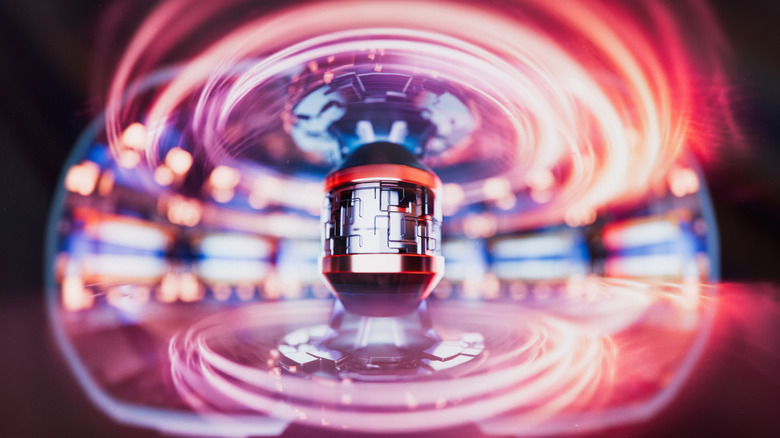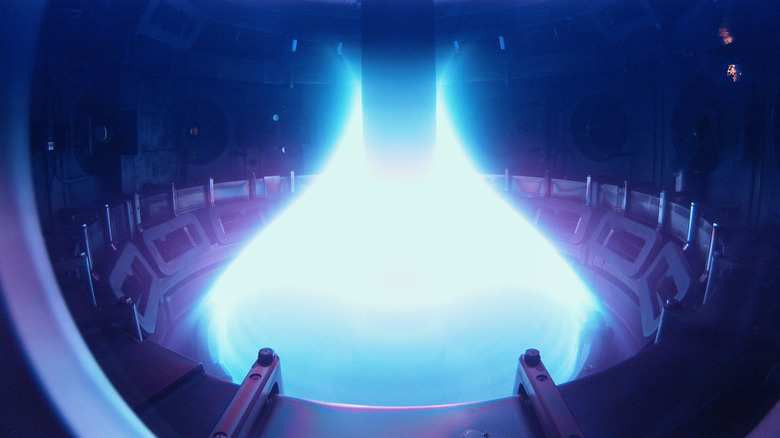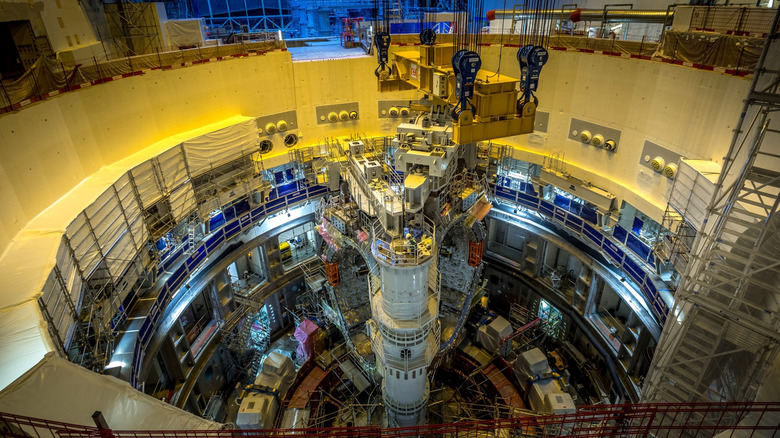How Does China's Artificial Sun Work?
The majority of the energy we use in our daily lives comes from the sun. Plants convert solar energy into carbohydrates, animals eat the plants, and then humans eat both. Some of those plants and animals decompose into fossil fuels, which we then use to heat our homes, charge our phones, and power our cars. But what if we could cut out the middleman? Over the past few years, scientists in China have made huge strides towards achieving that goal with the creation of an "artificial sun."
Of course, China hasn't literally made an artificial sun. Instead, scientists have been discovering ways to harness the nuclear process that powers the sun: fusion. Unlike the nuclear fission of modern nuclear reactors, in which atoms split apart, nuclear fusion combines two atoms into one. The fusion of hydrogen releases a massive amount of energy, with helium as its only byproduct. Fusion is therefore a cleaner energy source compared to fossil fuel combustion, which releases greenhouse gases, and the fission of radioactive isotopes, which releases radioactive waste.
Yet, fusion is incredibly difficult to control. For starters, it can only occur at extremely high temperatures and pressures. In the sun, the fusion of hydrogen occurs at millions of degrees and trillions of pascals of pressure. Such an environment turns the sun's matter into a plasma, the fourth state of matter. Considering the sun has a mass of about 2 octillion tons (that's a two with 27 zeroes behind it!), it's no wonder that it can reach such extreme conditions. Reaching those conditions in a lab, however, is a Herculean undertaking, and controlling them is even more challenging. That's why when China's Institute of Plasma Physics successfully produced plasma and kept it steadily contained for over 1,000 seconds on January 20th, 2025, it was a groundbreaking milestone.
The tokamak: A futuristic machine that can contain the sun's power
China's Institute of Plasma Physics achieved its breakthrough using a nuclear reactor called the Experimental Advanced Superconducting Tokamak, or EAST for short. Dozens of other tokamaks exist in scientific institutions around the world, but the EAST reactor is the only one to have successfully generated and maintained plasma stably for such a long period. Yet, considering all the technical complexities involved in engineering a machine that can harness and contain the power of the sun, the tokamak's basic principles are relatively easy to understand.
The first challenge for a tokamak reactor is the question of containment. Because plasma is so hot, no materials exist that can withstand contact with it long enough to contain it. Thus, rather than using a physical container, a tokamak suspends the plasma in a donut-shaped magnetic field — no contact required. To achieve this, the plasma is spun to orient its electrons in a single direction. This spin gives the plasma an electromagnetic charge that can be used to suspend it like a floating magnet.
Another challenge in creating an "artificial sun" is the pressure involved. In the sun's core, fusion occurs at 50 to 60 million degrees Fahrenheit and a pressure of 3.6 billion psi (246 billion times Earth's surface pressure). Reaching such high temperatures is comparatively easy; scientists in New York once hit 7 trillion degrees Fahrenheit in 2005. However, reaching such high pressures is far more difficult, especially when using electromagnets rather than compressible materials to contain the plasma. Thus, instead of emulating the sun's core, tokamak scientists take advantage of the direct relationship between temperature and pressure, as described in the ideal gas law. The plasma in the EAST reactor was brought to over 180 million degrees Fahrenheit, allowing the pressure to remain relatively low.
Why the Chinese tokamak doesn't melt at 180 million degrees Fahrenheit
Although the plasma in the EAST reactor doesn't come into contact with anything, it still radiates an intense amount of heat to the surrounding components. In fact, many of the technical challenges in designing a tokamak have less to do with the concept and more to do with the practicality of engineering a machine that won't melt or fail every time it's turned on. Thus, many of the components in a tokamak are made out of materials called high-temperature superconductors.
A conductor is any material through which electricity can flow with minimal resistance. Commonly used conductors, like copper wire, have some resistance, so they lose a fraction of their energy in the form of heat. Superconductors eliminate resistance nearly entirely. Most of the research into superconductors has focused on low-temperature superconducting materials, which can only achieve their near-zero resistance at extremely low temperatures. High-temperature superconductors, however, exhibit near-zero resistance even when exposed to extremely high temperatures. When building an "artificial sun" machine such as a tokamak, heat-resistant conductivity is critical for keeping the electromagnets running.
Most tokamak reactors around the world typically use low-temperature superconducting materials and conventional conducting materials, like copper. The EAST reactor, however, used a high-temperature superconducting material called rare earth barium copper oxide (REBCO) instead. REBCO doesn't require the massive cooling systems that low-temperature superconductors do to operate. Better yet, it's more energy-efficient, which is the main goal of fusion reactors: getting more energy out of the system than you put in. Ultimately, the more scientists like those behind China's "artificial sun" can reduce energy loss in fusion reactors, the closer we get to achieving the dream of clean energy.


